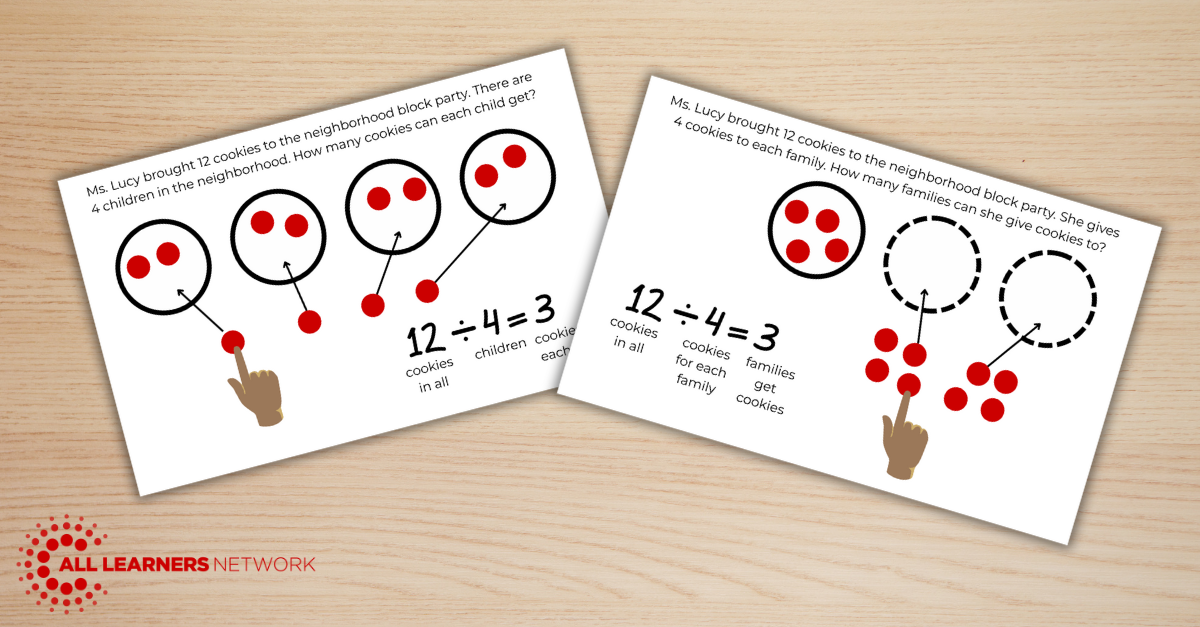
Sharing Vs Grouping: The Two Faces of Division
Published: May 30, 2025
Teachers in intermediate grades play a crucial role in introducing big ideas related to multiplicative thinking, including division. Many students come to school with prior experiences of sharing or grouping objects in their daily lives. They may have had experience sharing a batch of cookies with friends or figuring out how many teams there will be if 3 people can be on each team. These experiences can serve as a foundation for introducing the concept of division. It’s important for teachers to understand that division situations fall into two distinct categories: partitive division (also known as sharing division) and quotative division (also known as grouping or measurement division). As students progress through learning division, they will need to interact with both these types.
Some Division Story Problems
Here are examples of partitive and quotitive division problems. Read them and see if you can spot the differences between the two types of problems.
Partitive Division
- Ms. Lucy brought 12 cookies to the neighborhood block party. There are 4 children in the neighborhood. How many cookies can each child get?
- Mr. F has 28 students in his classroom. He wants to put them into 4 equal groups. How many students will be in each group?

Quotative Division
- Ms. Lucy brought 12 cookies to the neighborhood block party. She gives 4 cookies to each family. How many families can she give cookies to?
- Mr. F has 28 students in his classroom. He wants to put 4 students in each group. How many groups can he make?

What Differences Did You Notice?
Partitive division, or sharing division, is often the first type of division problem students encounter in grade 3. In these problems, we know the total number of objects and the number of groups. The goal is to determine how many objects go into each group. This type of problem is more intuitive for students because sharing objects one by one is a strategy that matches this scenario.
Quotative division, also called grouping or measurement division, is less commonly encountered by students early on in their learning of division. In these problems, we know the total number of objects and the size of each group. The goal is to determine how many groups can be formed. Unlike partitive division, grouping division does not align with the strategy of sharing out one by one, which is why it often receives less attention in classrooms.
Why Both Types of Division Matter
Students should be exposed to both partitive and quotative division contexts throughout their journey of learning division. From their initial lessons at the fact level to working with larger and more complex numbers, understanding both types of division is essential for developing a well-rounded understanding of the concept of division.
There are 9 common problem types that students should interact with around multiplication and division. Some of these are partitive division contexts, and some are quotitive. Check out the 9 problem types and see if you can spot the partitive and quotitive contexts.
Teachers need to ensure that students are familiar with the differences between partitive and quotitive division and have opportunities to practice both. This balanced approach helps students apply division flexibly in various real-world contexts and word problems.
By incorporating both perspectives into instruction, educators can better equip students with the skills they need to succeed in mathematics.
What Now?
1. Check out our blog, Engaging in Our World Through Math, and think about real-life contexts that are both partitive and quotative.
2. See how partitive and quotative division play out in our grades 3-5 High Leverage Concepts Progressions - available to our All Learners Online Unlimited members and to people who hire us for embedded professional development
3. Bring All Learners Network (ALN) into your school or district for embedded professional development.

All Learners Network is committed to supporting pedagogy so that all students can access quality math instruction. We do this through our online platform, free resources, events, and embedded professional development. Learn more about how we work with schools and districts here.





